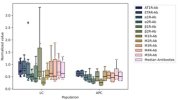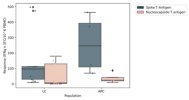P109 Circulating autoantibodies targeting G-protein-coupled neurotransmitter receptors: reliable biomarkers for long COVID diagnosis?
M Camici, M Franco, L Talamanca, E Cimini, E Tartaglia, S Notari, M Petino, L Scarnecchia, A Vergori, R Baldelli, P Zuppi, A Antinori
[Line breaks added]
Background
Emerging evidence suggests that IgG transfer from Long-COVID (LC) patients induces symptoms in mice. Auto-Abs against G-protein-coupled (GPCR Abs) neurotransmitter receptors are linked to chronic fatigue syndrome, which overlaps with LC. This study investigates these Auto-Abs in LC patients to identify potential biomarkers and therapeutic targets.
Methods
A prospective, pilot, single-center case-control study was conducted at the LC clinic in Rome. Fifteen participants were enrolled: four asymptomatic post-COVID (APC) individuals and eleven with severe LC, defined as the presence of at least four symptoms—fatigue, cognitive deficits, poor exercise tolerance, dyspnea, arthralgia, or dysautonomia—more than three months post-SARS-CoV-2 infection.
Fatigue was assessed using the Fatigue Assessment Scale (FAS ≥ 22; severe: FAS ≥ 35). Auto-Abs against multiple receptors, including AT1R, endothelin receptor A, adrenergic (α1, α2, β1, β2), and muscarinic (M1-M5) receptors, were measured. Blood samples were analyzed for stress hormones (cortisol, ACTH). SARS-CoV-2 specific T cell response to Spike and Nucleocapsid antigens were assessed by Elispot assay.
Results
LC patients were younger than the APC, had more comorbidities (p=0.007), received fewer vaccine doses (p=0.04), and were more likely to engage in sports (p<0.001). Median FAS score was significantly higher in LC than APC (33 vs 12; p=0.001).
The median levels of the studied Auto-GPCR Abs showed a higher trend in LC patients compared to APC individuals (8398 pg/ml vs 5637 pg/ml; p=0.2), as was the case for each specific Auto-Ab studied (figure 1). We were able to make use of these differences in antibodies between APC and LC and we developed a diagnostic method for identifying LC with no false positives based on the Auto-Abs normalized levels.
Median blood morning cortisol was statistically higher in APC than LC (17 mg/dl vs 12.7 mg/dl; p= 0.01). There was also a trend toward a better specific T-cell response to the S and N antigens in APC compared to LC (figure 2). Correlations between the studied variables are shown in figure 3.
Our pilot study suggests GPCR Abs help identify LC patients who may benefit from IV immunoglobulin or plasmapheresis. Further research is needed to assess treatment effectiveness.
Link | PDF (Sexually Transmitted Infections) [Poster abstract]
M Camici, M Franco, L Talamanca, E Cimini, E Tartaglia, S Notari, M Petino, L Scarnecchia, A Vergori, R Baldelli, P Zuppi, A Antinori
[Line breaks added]
Background
Emerging evidence suggests that IgG transfer from Long-COVID (LC) patients induces symptoms in mice. Auto-Abs against G-protein-coupled (GPCR Abs) neurotransmitter receptors are linked to chronic fatigue syndrome, which overlaps with LC. This study investigates these Auto-Abs in LC patients to identify potential biomarkers and therapeutic targets.
Methods
A prospective, pilot, single-center case-control study was conducted at the LC clinic in Rome. Fifteen participants were enrolled: four asymptomatic post-COVID (APC) individuals and eleven with severe LC, defined as the presence of at least four symptoms—fatigue, cognitive deficits, poor exercise tolerance, dyspnea, arthralgia, or dysautonomia—more than three months post-SARS-CoV-2 infection.
Fatigue was assessed using the Fatigue Assessment Scale (FAS ≥ 22; severe: FAS ≥ 35). Auto-Abs against multiple receptors, including AT1R, endothelin receptor A, adrenergic (α1, α2, β1, β2), and muscarinic (M1-M5) receptors, were measured. Blood samples were analyzed for stress hormones (cortisol, ACTH). SARS-CoV-2 specific T cell response to Spike and Nucleocapsid antigens were assessed by Elispot assay.
Results
LC patients were younger than the APC, had more comorbidities (p=0.007), received fewer vaccine doses (p=0.04), and were more likely to engage in sports (p<0.001). Median FAS score was significantly higher in LC than APC (33 vs 12; p=0.001).
The median levels of the studied Auto-GPCR Abs showed a higher trend in LC patients compared to APC individuals (8398 pg/ml vs 5637 pg/ml; p=0.2), as was the case for each specific Auto-Ab studied (figure 1). We were able to make use of these differences in antibodies between APC and LC and we developed a diagnostic method for identifying LC with no false positives based on the Auto-Abs normalized levels.
Median blood morning cortisol was statistically higher in APC than LC (17 mg/dl vs 12.7 mg/dl; p= 0.01). There was also a trend toward a better specific T-cell response to the S and N antigens in APC compared to LC (figure 2). Correlations between the studied variables are shown in figure 3.
Our pilot study suggests GPCR Abs help identify LC patients who may benefit from IV immunoglobulin or plasmapheresis. Further research is needed to assess treatment effectiveness.
Link | PDF (Sexually Transmitted Infections) [Poster abstract]



